牛津深圳版 Module 3 Unit 6 Travelling around Asia Reading 课件 (共22张PPT)
文档属性
| 名称 | 牛津深圳版 Module 3 Unit 6 Travelling around Asia Reading 课件 (共22张PPT) | 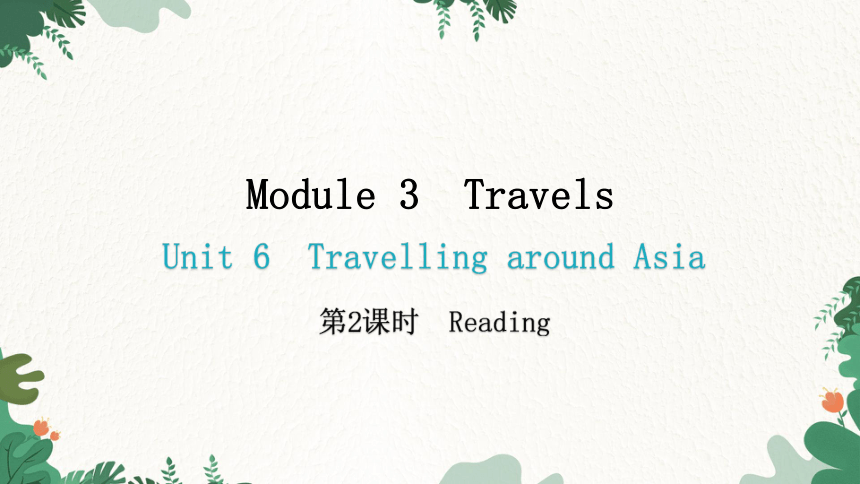 | |
| 格式 | pptx | ||
| 文件大小 | 2.2MB | ||
| 资源类型 | 教案 | ||
| 版本资源 | 牛津深圳版 | ||
| 科目 | 英语 | ||
| 更新时间 | 2022-08-13 09:48:37 | ||
图片预览


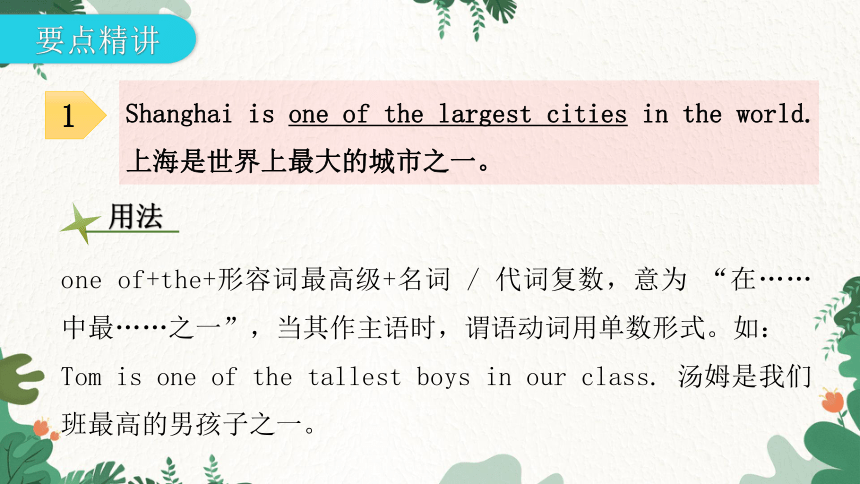
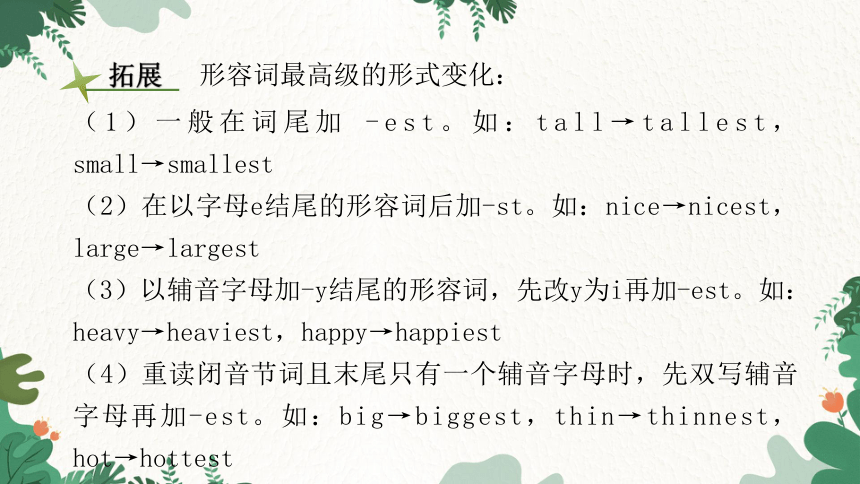
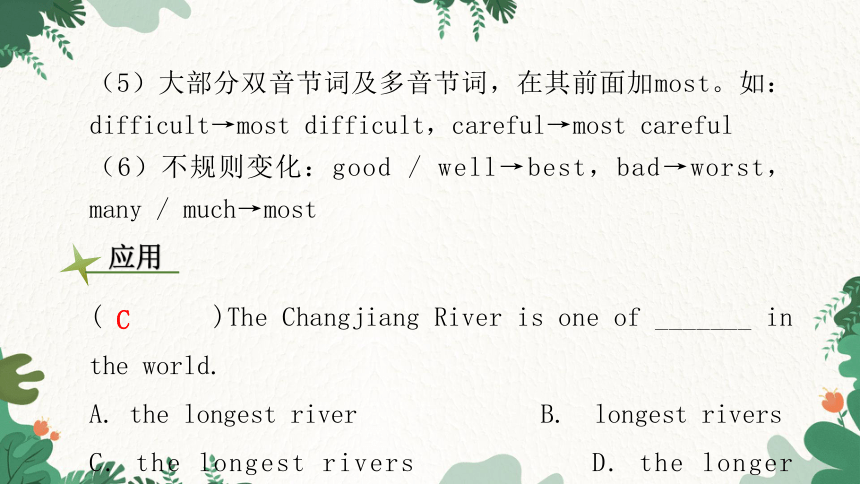
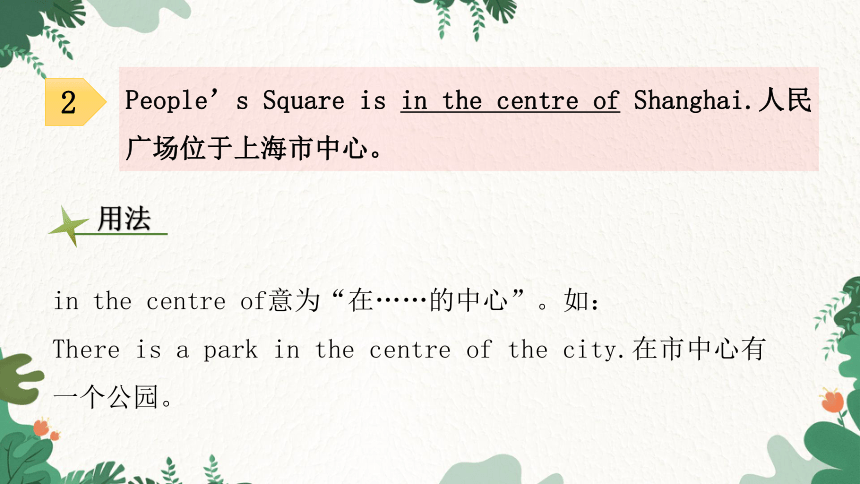
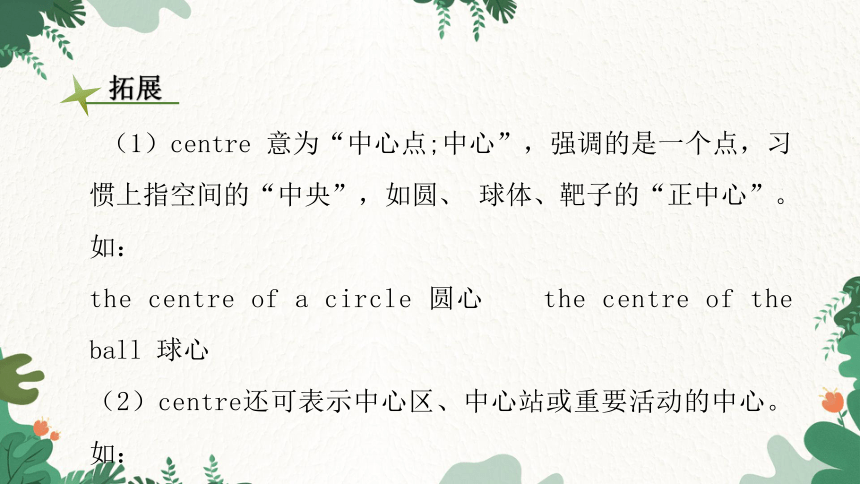
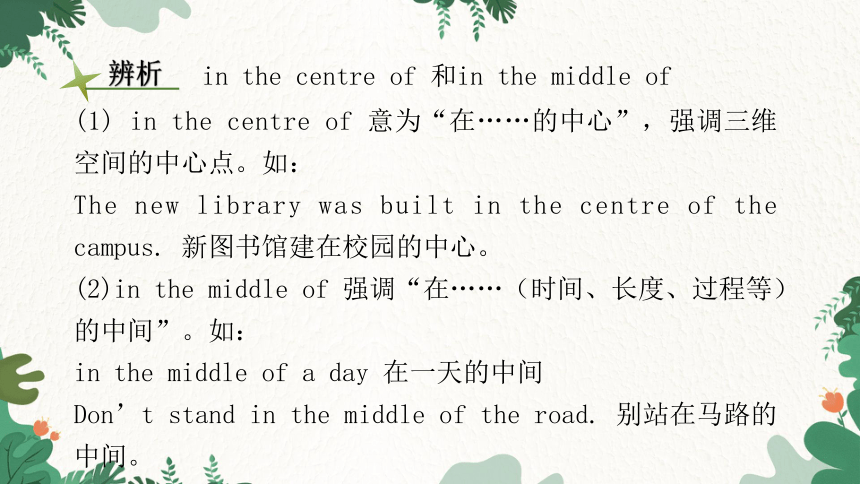
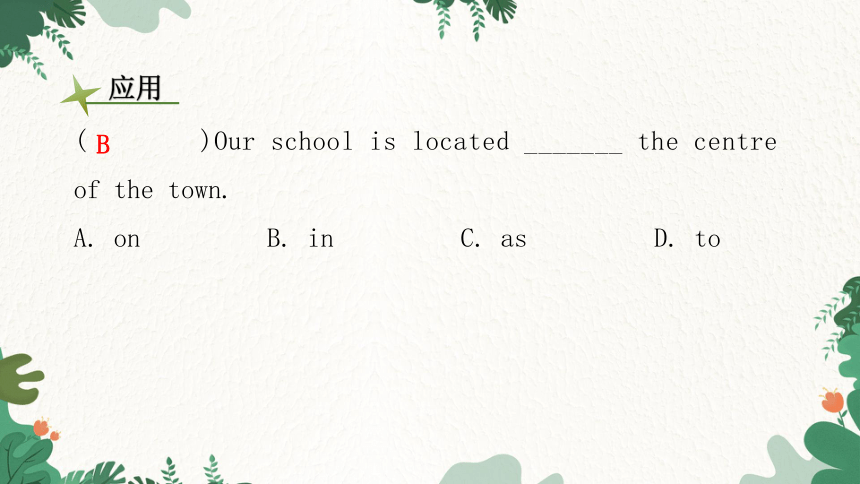
文档简介
(共22张PPT)
Module 3 Travels
Unit 6 Travelling around Asia
第2课时 Reading
目录
01
要点精讲
02
课堂练习
要点精讲
1
Shanghai is one of the largest cities in the world. 上海是世界上最大的城市之一。
one of+the+形容词最高级+名词 / 代词复数,意为 “在……中最……之一”,当其作主语时,谓语动词用单数形式。如:
Tom is one of the tallest boys in our class. 汤姆是我们班最高的男孩子之一。
用法
(1)一般在词尾加 -est。如:tall→tallest,small→smallest
(2)在以字母e结尾的形容词后加-st。如:nice→nicest,large→largest
(3)以辅音字母加-y结尾的形容词,先改y为i再加-est。如:heavy→heaviest,happy→happiest
(4)重读闭音节词且末尾只有一个辅音字母时,先双写辅音字母再加-est。如:big→biggest,thin→thinnest,hot→hottest
拓展
形容词最高级的形式变化:
(5)大部分双音节词及多音节词,在其前面加most。如:difficult→most difficult,careful→most careful
(6)不规则变化:good / well→best,bad→worst, many / much→most
应用
( )The Changjiang River is one of _______ in the world.
A. the longest river B. longest rivers
C. the longest rivers D. the longer river
C
2
People’s Square is in the centre of Shanghai.人民广场位于上海市中心。
用法
in the centre of意为“在……的中心”。如:
There is a park in the centre of the city.在市中心有一个公园。
拓展
(1)centre 意为“中心点;中心”,强调的是一个点,习惯上指空间的“中央”,如圆、 球体、靶子的“正中心”。如:
the centre of a circle 圆心 the centre of the ball 球心
(2)centre还可表示中心区、中心站或重要活动的中心。如:
the shopping centre 购物中心 the town centre 镇中心
辨析
(1) in the centre of 意为“在……的中心”,强调三维空间的中心点。如:
The new library was built in the centre of the campus. 新图书馆建在校园的中心。
(2)in the middle of 强调“在……(时间、长度、过程等)的中间”。如:
in the middle of a day 在一天的中间
Don’t stand in the middle of the road. 别站在马路的中间。
in the centre of 和in the middle of
应用
( )Our school is located _______ the centre of the town.
A. on B. in C. as D. to
B
3
If you visit People’s Square, you can also see famous buildings around it, such as the Shanghai Grand Theatre and the Shanghai Museum. 如果你参观人民广场,你还可以看到它周围的著名建筑,如上海大剧院和上海博物馆。
用法
(1)around 在此作介词,意为“在……的周围”。如:
The girls around the teacher seemed excited. 围着老师的那些女生看起来很兴奋。
around 还可作副词,意为“大约”,相当于about。如:
He goes to school at around 7:00 every day. 他每天大约7点去上学。
(2)such as 意为“例如”,用于列举整体多个种类的人或事物,前面一般用逗号和主句隔开,相当于like。如:
She likes all the subjects, such as English, Maths, Chinese and History.= She likes all the subjects,like English, Maths,Chinese and History. 她喜欢所有科目,例如英语、数学、语文和历史。
拓展
for example 也表示“例如”,但是for example用于列举整体中的一个例子,其后有逗号。如:
There is much happiness in our daily lives. For example, we have friends to play with. 生活中有很多快乐,比如我们有很多朋友可以一起玩。
应用
(1)我家大约有100本书。
I _________ ___________ 100 books at my home.
(2)用such as或for example填空
①We should follow the school rules. _________ _________, we should not smoke.
②There are many animals at the zoo, _________ _________ tigers, lions and elephants.
have
around
For
example
such
as
课堂练习
一、根据汉语意思,完成句子
1. 王小姐打算在市中心买一栋房子。
Miss Wang is going to buy a house _________ _________ _________ _________ the city.
2. 明天我想去参观名胜古迹。
I want to visit _________ _________ __________ tomorrow.
in
the
centre
of
places
of
interest
3. 我们应该多吃水果,例如苹果和香蕉。
We should eat more fruits, _________ _________ apples and bananas.
4. 这些现代建筑在夜晚将天空点亮。
These modern buildings _________ _________ the sky at night.
5. 这家酒店在城市的西北边。
The hotel lies ______ _______ _____________ ______ the city.
such
as
light
up
in
the
north-west
of
二、本课时主要短语串联应用(用方框内所给短语的适当形式填空)
natural beauty, in the centre of, place of interest, travel guide, close to
Beijing is the capital of China. If you visit Beijing, you will see both modern and traditional buildings. Tian’anmen Square is
1. _______________ Beijing. If you want to learn more about China, you can visit the museums 2. _______________ Tian’anmen Square.
in the centre of
close to
At the Palace Museum, you can enjoy both the 3. _____________ and traditional Chinese buildings. We will provide you with a
4. _____________ to help you better enjoy your stay in this great city. For more information about 5. ________________ in Beijing, please contact(联系) us.
natural beauty
travel guide
places of interest
三、阅读填空
请阅读短文,并从下列方框里的六个句子中选择五个还原到原文中,使原文的意思完整、连贯。
A. Sometimes they have to camp outside.
B. Maybe you are too young to do it.
C. There are usually six or eight beds in each room.
D. Backpacking lets travellers see more.
E. They are called backpackers.
F. The trip will be cheap.
The national holiday is coming. Many people want to travel. How about backpacking (背包旅行) 1. _________ But we will get to know this interesting way to travel.
Many people go to see the world by themselves. They carry big bags on their backs. They wear jeans and T-shirts. They have guidebooks and maps in their hands. 2. _____
These backpackers don’t travel with tour groups. They do homework about their destinations (目的地) themselves. What food to eat Where to stay What to buy and how to change trains
B
E
In their bags, they have clothes and medicine. Some of them also have a tent (帐篷) and a sleeping bag. 3. _________
Most backpackers stay in hostels (青年旅舍) during their trips. Hostels are like dorms (宿舍). They are cheap. 4. _____ People from different countries become friends there.
5. _____ American backpacker Charles Veley goes to over 190 countries in ten years! “To live is to see the world as much as possible,” he says.
A
C
D
谢 谢!
Module 3 Travels
Unit 6 Travelling around Asia
第2课时 Reading
目录
01
要点精讲
02
课堂练习
要点精讲
1
Shanghai is one of the largest cities in the world. 上海是世界上最大的城市之一。
one of+the+形容词最高级+名词 / 代词复数,意为 “在……中最……之一”,当其作主语时,谓语动词用单数形式。如:
Tom is one of the tallest boys in our class. 汤姆是我们班最高的男孩子之一。
用法
(1)一般在词尾加 -est。如:tall→tallest,small→smallest
(2)在以字母e结尾的形容词后加-st。如:nice→nicest,large→largest
(3)以辅音字母加-y结尾的形容词,先改y为i再加-est。如:heavy→heaviest,happy→happiest
(4)重读闭音节词且末尾只有一个辅音字母时,先双写辅音字母再加-est。如:big→biggest,thin→thinnest,hot→hottest
拓展
形容词最高级的形式变化:
(5)大部分双音节词及多音节词,在其前面加most。如:difficult→most difficult,careful→most careful
(6)不规则变化:good / well→best,bad→worst, many / much→most
应用
( )The Changjiang River is one of _______ in the world.
A. the longest river B. longest rivers
C. the longest rivers D. the longer river
C
2
People’s Square is in the centre of Shanghai.人民广场位于上海市中心。
用法
in the centre of意为“在……的中心”。如:
There is a park in the centre of the city.在市中心有一个公园。
拓展
(1)centre 意为“中心点;中心”,强调的是一个点,习惯上指空间的“中央”,如圆、 球体、靶子的“正中心”。如:
the centre of a circle 圆心 the centre of the ball 球心
(2)centre还可表示中心区、中心站或重要活动的中心。如:
the shopping centre 购物中心 the town centre 镇中心
辨析
(1) in the centre of 意为“在……的中心”,强调三维空间的中心点。如:
The new library was built in the centre of the campus. 新图书馆建在校园的中心。
(2)in the middle of 强调“在……(时间、长度、过程等)的中间”。如:
in the middle of a day 在一天的中间
Don’t stand in the middle of the road. 别站在马路的中间。
in the centre of 和in the middle of
应用
( )Our school is located _______ the centre of the town.
A. on B. in C. as D. to
B
3
If you visit People’s Square, you can also see famous buildings around it, such as the Shanghai Grand Theatre and the Shanghai Museum. 如果你参观人民广场,你还可以看到它周围的著名建筑,如上海大剧院和上海博物馆。
用法
(1)around 在此作介词,意为“在……的周围”。如:
The girls around the teacher seemed excited. 围着老师的那些女生看起来很兴奋。
around 还可作副词,意为“大约”,相当于about。如:
He goes to school at around 7:00 every day. 他每天大约7点去上学。
(2)such as 意为“例如”,用于列举整体多个种类的人或事物,前面一般用逗号和主句隔开,相当于like。如:
She likes all the subjects, such as English, Maths, Chinese and History.= She likes all the subjects,like English, Maths,Chinese and History. 她喜欢所有科目,例如英语、数学、语文和历史。
拓展
for example 也表示“例如”,但是for example用于列举整体中的一个例子,其后有逗号。如:
There is much happiness in our daily lives. For example, we have friends to play with. 生活中有很多快乐,比如我们有很多朋友可以一起玩。
应用
(1)我家大约有100本书。
I _________ ___________ 100 books at my home.
(2)用such as或for example填空
①We should follow the school rules. _________ _________, we should not smoke.
②There are many animals at the zoo, _________ _________ tigers, lions and elephants.
have
around
For
example
such
as
课堂练习
一、根据汉语意思,完成句子
1. 王小姐打算在市中心买一栋房子。
Miss Wang is going to buy a house _________ _________ _________ _________ the city.
2. 明天我想去参观名胜古迹。
I want to visit _________ _________ __________ tomorrow.
in
the
centre
of
places
of
interest
3. 我们应该多吃水果,例如苹果和香蕉。
We should eat more fruits, _________ _________ apples and bananas.
4. 这些现代建筑在夜晚将天空点亮。
These modern buildings _________ _________ the sky at night.
5. 这家酒店在城市的西北边。
The hotel lies ______ _______ _____________ ______ the city.
such
as
light
up
in
the
north-west
of
二、本课时主要短语串联应用(用方框内所给短语的适当形式填空)
natural beauty, in the centre of, place of interest, travel guide, close to
Beijing is the capital of China. If you visit Beijing, you will see both modern and traditional buildings. Tian’anmen Square is
1. _______________ Beijing. If you want to learn more about China, you can visit the museums 2. _______________ Tian’anmen Square.
in the centre of
close to
At the Palace Museum, you can enjoy both the 3. _____________ and traditional Chinese buildings. We will provide you with a
4. _____________ to help you better enjoy your stay in this great city. For more information about 5. ________________ in Beijing, please contact(联系) us.
natural beauty
travel guide
places of interest
三、阅读填空
请阅读短文,并从下列方框里的六个句子中选择五个还原到原文中,使原文的意思完整、连贯。
A. Sometimes they have to camp outside.
B. Maybe you are too young to do it.
C. There are usually six or eight beds in each room.
D. Backpacking lets travellers see more.
E. They are called backpackers.
F. The trip will be cheap.
The national holiday is coming. Many people want to travel. How about backpacking (背包旅行) 1. _________ But we will get to know this interesting way to travel.
Many people go to see the world by themselves. They carry big bags on their backs. They wear jeans and T-shirts. They have guidebooks and maps in their hands. 2. _____
These backpackers don’t travel with tour groups. They do homework about their destinations (目的地) themselves. What food to eat Where to stay What to buy and how to change trains
B
E
In their bags, they have clothes and medicine. Some of them also have a tent (帐篷) and a sleeping bag. 3. _________
Most backpackers stay in hostels (青年旅舍) during their trips. Hostels are like dorms (宿舍). They are cheap. 4. _____ People from different countries become friends there.
5. _____ American backpacker Charles Veley goes to over 190 countries in ten years! “To live is to see the world as much as possible,” he says.
A
C
D
谢 谢!
